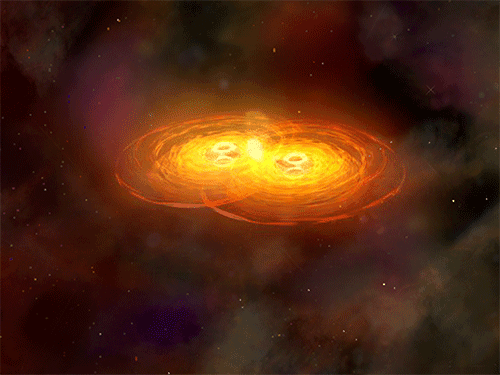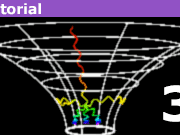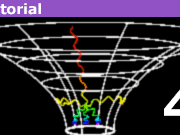What Are the Thermodynamics of Black Holes? A 5 Minute Introduction
Table of Contents
Definition/Summary
The four laws of black hole thermodynamics are as follows…

The Zeroth Law
Surface gravity [itex](\kappa)[/itex] is constant over a black holes event horizon.
The First Law
‘This law deals with the mass (energy) change, dM when a black hole switches from one stationary state to another.’ The following (in natural units) applies-
[tex]dM=\frac{\kappa}{8\pi}\,dA\,+\,\Omega\,dJ\,+\,\Phi\,dQ[/tex]
where the first term is relative to irreducible mass- [itex]M_{ir}=\sqrt(A/16\pi)[/itex], the second to rotation- J and the third to charge- Q.
In accordance with Cosmic censorship: [itex]Q\leq M,\ a\leq M,\ J=aM\leq M^2[/itex] and [itex]Q^2+a^2\leq M^2[/itex] where [itex]M=Gm/c^2[/itex].
##\begin{align*}& A=4\pi\left( 2M^2-Q^2+2M\sqrt{M^2-Q^2-a^2}\right)\\& \kappa=\frac{4\pi \sqrt{M^2-Q^2-a^2}}{A}\\& \Omega=\frac{4\pi\ ,a}{A}\\& \Phi=\frac{4\pi\, Q\, r_+}{A}\end{align*}##
where [itex]r_+=M+\sqrt(M^2-Q^2-a^2)[/itex]
A is the surface area of the black hole, [itex]\kappa[/itex] is the surface gravity of the black hole, [itex]\Omega[/itex] is the angular velocity, [itex]\Phi[/itex] is the electrostatic potential and [itex]r_+[/itex] is the outer event horizon.
(for SI units, multiply the surface gravity* [itex](\kappa)[/itex] by c² for m/s² and the angular velocity** [itex](\Omega)[/itex] by c for rad/s)
*’..For a black hole, which can only be truly treated relativistically, one cannot define a surface gravity as the acceleration experienced by a test body at the object’s surface. This is because the acceleration of a test body at the event horizon of a black hole turns out to be infinite in relativity. Therefore, when one talks about the surface gravity of a black hole, one is defining a notion that behaves analogously to the Newtonian surface gravity, but is not the same thing..’
Source- wikipedia, Surface Gravity
**As viewed from infinity.
The Second Law
In any classical process, the area of the event horizon does not decrease
[tex]dA\geq 0[/tex]
nor does the black hole’s entropy, [itex]S_{bh}[/itex] (the black hole’s event horizon area can remain stable in classical mechanics but will increase 1) if mass is added or 2) if spin or charge are reduced). The second law of black hole mechanics can, however, be violated if the quantum effect is taken into account, namely that the area of the event horizon can be reduced via Hawking radiation.
The Third Law
‘The limit [itex]\kappa=0[/itex] cannot be reached within a finite time, in other words, regardless of how many processes are involved, the black hole will never reach the limit [itex]\kappa=0[/itex]. However, extremal black holes, for example the Kerr black hole in which a/M=1, do have [itex]\kappa=0[/itex] thus zero temperature (absolute zero) but non-zero entropy. To actually reduce the surface gravity to zero is merely an idealized case because it is forbidden by the Cosmic censorship conjecture.’
Extended explanation
The First Law (cnt)
The first term, [itex](\kappa/8\pi)\,dA[/itex], is derived from the temperature (T[SUB]H[/SUB]) and entropy (S[SUB]bh[/SUB]) of the black hole (in SI units)-
[tex]\begin{align*}& T_{\text{H}}=\frac{\hbar \kappa}{2\pi c k_{\text{B}}}\\& S_{\text{bh}}=\frac{k_{\text{B}}c^3}{4\hbar G}A\\\end{align*}[/tex]
where ħ is the reduced Planck constant, κ is the surface gravity of the black hole and k[SUB]B[/SUB] is the Boltzmann constant.
In natural units: [itex]T_{\text{H}}=\kappa/2\pi,\ S_{\text{bh}}=A/4[/itex]
The first law of black hole mechanics is analogous with the first law of thermodynamics-
[itex]dE=T\,dS[/itex] + work terms
where T is temperature and dS is the change in the entropy of the system.
For a black hole-
[itex]dM=T_{\text{H}}\,dS_{\text{bh}}[/itex] + work terms
in SI units (derived from the equations for T[SUB]H[/SUB] and S[SUB]bh[/SUB])-
[itex]T_{\text{H}}\,dS_{\text{bh}}=\frac{c^2\kappa}{8\pi G}\,dA[/itex]
which in natural units is [itex]T_{\text{H}}\,dS_{\text{bh}}=(\kappa/8\pi)\,dA[/itex]
This article was authored by several Physics Forums members with PhDs in physics or mathematics.










Leave a Reply
Want to join the discussion?Feel free to contribute!